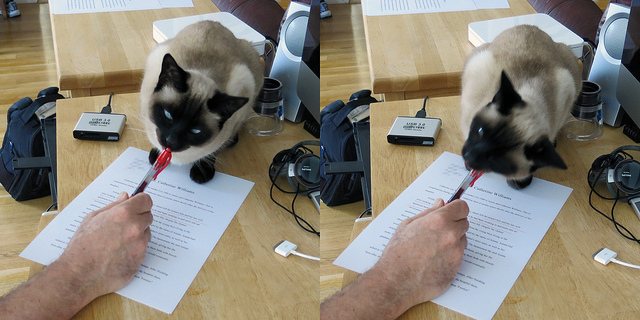
Perhaps the most serious crime (yes, crime) a student or researcher can commit is that of plagiarism. Plagiarism is the act of copying another person’s words and passing them off as if they are your own. It bears repeating: PLAGIARISM IS A CRIME in academia. Although it won’t earn you a jail sentence, if you are found guilty of plagiarism, the consequences can be severe. If you are a student, plagiarism can cause you to be expelled from school. If you are a researcher or professor, plagiarism can cost you your career.
Therefore, it is important to know how to avoid plagiarism. Editors see examples of plagiarism on a regular basis; sometimes, students do not realize they are plagiarizing. The most common cause of plagiarism seems to be a failure to cite properly, whether due to unfamiliarity with how to cite direct quotations and ideas or simple oversight; the second-most common cause (again, based on my observations) seems to come from the student’s lack of confidence in his or her own ability to write. In the remainder of this blog post, I will address both of these causes and explain how easy it is for one to be caught plagiarizing.
- Example 1: Improper citation of a direct quote:
Let’s say you’re a special ed major, and are writing a paper on social skills for people with autism. A currently popular book on this subject is Unwritten Rules of Social Relationships, which happens to be written by two people who are on the autism spectrum.
You write the following:
People with various forms of autism view the world much differently than people without autism. This perspective is inborn, is due to how their brains are ‘wired,’ and is true no matter where on the autism spectrum the person lies. According to Grandin and Barron, the mind of a person with autism is one of absolutes, of thinking patterns that are rigid and repetitive, where minute details become focal points of obsessive attention, and self-involvement takes precedence over exploration.
The plagiarism starts in line 4 of the above paragraph, with “is one of absolutes…” I will now show you how to properly cite this in APA and MLA formats.
APA: People with various forms of autism view the world much differently than people without autism. This perspective is inborn, is due to how their brains are ‘wired,’ and is true no matter where on the autism spectrum the person lies. According to Grandin and Barron (2005), the mind of a person with autism “is one of absolutes, of thinking patterns that are rigid and repetitive, where minute details become focal points of obsessive attention, and self-involvement takes precedence over exploration” (p. 83).
MLA: People with various forms of autism view the world much differently than people without autism. This perspective is inborn, is due to how their brains are ‘wired,’ and is true no matter where on the autism spectrum the person lies. According to Grandin and Barron, the mind of a person with autism “is one of absolutes, of thinking patterns that are rigid and repetitive, where minute details become focal points of obsessive attention, and self-involvement takes precedence over exploration” (Grandin and Barron 83).
Note that, in both examples, the actual copied text is enclosed in quotation marks, and that the period that ends the sentence comes after the citation.
-
Example 2: Improper citation of someone else’s idea
In another spot in your paper on social skills, you note the following:
In people with autism, social functioning is often so impaired that what is inherent to, or can be learned through observation by, those without autism (“neurotypicals”) can only be learned through direct experience.
This, too, is plagiarism because it’s not a commonly known fact. It’s a rephrasing, in your own words, from Unwritten Rules of Social Relationships. In APA, you don’t need a page number because there is no direct quotation; however, in MLA, you do need a page number because every MLA citation requires a page number. See below for citation examples.
APA: In people with autism, social functioning is often so impaired that what is inherent to, or can be learned through observation by, those without autism (“neurotypicals”) can only be learned through direct experience (Grandin & Barron, 2005).
MLA: In people with autism, social functioning is often so impaired that what is inherent to, or can be learned through observation by, those without autism (“neurotypicals”) can only be learned through direct experience (Grandin & Barron 32).
-
Example 3: Possible lack of confidence in writing skills
This type of plagiarism takes place when large sections, if not all, of a paper are copied straight from a source. This is easy to spot when a large segment of a paper is clearly in a different writing style/fluency from the rest of the paper. I prefer to give people the benefit of the doubt, and assume they are doing it either because they don’t know it’s wrong or because they don’t have confidence in their own writing abilities, but deliberate plagiarism can and does happen. I wish to reiterate that plagiarism is often used as grounds for expulsion, as well as termination and loss of professional licenses.
Returning to the special ed paper on people with autism, you’ve spent several pages discussing common ways to help people with autism learn social skills; now it is now time for the conclusion. The paragraph prior to the conclusion might say something like this (spelling and grammar errors are intentional):
Even though people with autism arent born perceiving the world the way people without autism do. And though they lack social skills that most people are born with, it is greatly importance to teach them these skills so they can relate to others.
Then, suddenly, the conclusion switches to this perfect text:
Conclusion:
We have to look at the physical biomedical/biochemical workings of the person, assess their sensory issues, determine whether they think from a logical or emotional framework, and then create programs that take into consideration all of these factors if we’re going to teach social functioning skills and emotional relatedness to people with ASD. Yet, many programs with a social or behavioral basis teach good/bad behavior and expect behavior conditioning to produce social understanding. That’s exactly the stage where much of our programming sits now with people with ASD – a piecemeal, compartmentalized approach to treatment.
If there’s a basic physiological reason that social awareness is not developing in a child – their brain wires are not connected – no matter how many ways parents or professionals try to teach the child, success will be limited by that physical impairment. If his sensory systems are going haywire all the time, or stress and anxiety levels are pervasive, until those issues are addressed and alleviated, forget trying to teach more advanced aspects of behavior and sociability. Equally ineffective are mismatched teaching methods, such as appealing to the logical-minded child through emotional reasoning, or vice versa. Until we address the whole child in our teaching – whether we’re teaching language or social skills or play skills – we’re doing disservice to the child or adult. We’re expecting a lot of effort from the child, but setting him up for limited success right from the start. It all comes back to appreciating the different ways that people with ASD think.
While the text in the conclusion sounds great and may say exactly what you were trying to, it is, nevertheless, plagiarized (taken directly from pages 92 and 93 of The Unwritten Rules of Social Relationships). There is no way around this, no way to pass this off. Rewriting or spinning this is just as unacceptable as leaving it as is, and just inserting quotes and a citation is inappropriate because of the length of the passage. Every bit of your paper, except SHORT quotations, as in example 1, must be in your own writing; when an idea is explained that is someone else’s idea, it must also be cited, as in example 2. This entire conclusion must be deleted and a new one written in your own words.
Finding plagiarism (and ways to double check yourself):
Plagiarism is easy to find; the most basic way is to Google passages from the paper. If the passage comes up verbatim in the search results… you have been caught! (For instance, I Googled just a few words of the passage in the example above; the first search result returned was here: Google Result).
There are more sophisticated ways to do it, however, on sites such as The Plagiarism Checker and Copyscape. It is likely that your professors use one or more of these more sophisticated tools.
In conclusion, plagiarism is never worth it. Be aware of what it is, and be scrupulous about making sure you never commit it.

